In 1912 Giovanni set up his own workshop where he employed a couple of people and together they constructed and repaired coach bodies.
After a very difficult period during the First World War the workshop gradually returned to normal and in 1921 constructed its
first car body, for a SPA 23S. The same chassis was also used for the construction of a bus, whilst his closeness to the Lancia
factory saw Bertone establish a good relationship with the latter. Cars followed based on Fiat, Scat, Diatto, Chiribiri and
other chassis, notable amongst these early works the Fiat 501 Sport.
In the period of the 1920s and 30s the majority of cars were produced as chassis and then fitted with a personalised body
by firms such as Bertone. As the major manufacturers moved into mass production of complete cars the coachbuilders had to look
Designs by Mario Revelli de Beaument for the Ardita and Balilla were amongst the best known to be produced by Bertone during the
early 1930s. These were followed by the release of the Fiat 1500 which was then used as the basis for several cabriolet and
saloon versions, again designed by Revelli and built by Bertone. Alongside the many cars, they also built a variety of ambulances,
electric powered light commercial vehicles, taxis, buses and military transports. The subsequent launches of the
Fiat 500 and Lancia Aprilia
provided more than sufficient material for the ever expanding Bertone, with cabriolets, saloons, coupes and other styles using
those and other chassis. The worsening political situation in Europe, however, dampened the market and most non-military work ceased
when the conflict began.
After the war the situation in Italy was not ideal for a manufacturer of what were essentially luxury items, but Bertone adapted
to the situation and, unlike many, survived. Old cars were rebodied with new styles and collaboration with the major manufacturers
saw the coachbuilder becoming more involved in the initial design procedure. The same time saw Nuccio Bertone finally enter the
In those years, the Fiat 1100 served as the basis for most of Bertones products, but the 1950
launches of the Fiat 1400, Lancia Aurelia and
Alfa Romeo 1900 saw a significant increase in possibilities. Older models such as the
Fiat 500 also accounted for a not insignificant volume.
From 1952 Bertone also spread their influence across the Altantic, building a series of cars for Arnolt, an American MG importer.
A number of cars were built on MG chassis followed by various spiders and a coupé which used a Bristol chassis. The Arnolt-Bristol
was designed by the then little known Franco Scaglione who was working alongside another now famous name, Giovanni Michelotti at
the Bertone establishment.
The ever decreasing cost of mass-produced cars, and the increasing cost of specially built versions led Bertone to seek ever closer
ties with the major manufacturers. The breakthrough for Bertone came in the early 1950s with the Alfa Romeo Giulietta Sprint,
launched in 1954. Originally intended to be produced in very small numbers, it went on to be built by the thousand and saw Bertone
enter the ranks of the volume producers.
Mention has to be made at this time of the BAT series of cars
built on the Alfa Romeo 1900 chassis. Designed by Scaglione and built
by Bertone they are futuristic looking even today. Returning to more utilitarian vehicles, the arrival of the Fiat 600
in 1955 made it ever harder for the coachbuilders to compete with the manufacturers, and saw Bertone moving more into both the sportscar
The experience of the Giulietta Sprint, together with the move to a much larger new premises at Grugliasco (on the outskirts of Turin)
also enabled Bertone to offer more to the manufacturers, from design right up to limited volume production. Around this time another
later-famous young designer joined Bertone, Giorgetto Giugiaro. This new potential of Bertone, the Grugliasco plant in 1961 could build
up to 7500 bodies per year, saw contracts with Simca (the 1000 Coupe) and Iso (the IR300) whilst notable designs of those years included
the Alfa Romeo 2000 Sprint, the ASA 1000 and a one-off Ferrari 250GT.
The Iso IR300 led to the Grifo, whilst Alfa Romeo also turned to
Bertone for the replacement of the Giulietta Sprint. The resulting Giulia GT went on to be manufactured in large numbers for many years.
These years saw little work for Bertone from Fiat and Lancia and so a determined effort was made to re-enter this sphere. The most
immediate result was the Fiat 850 Spider released in 1965, which went on to be most successful,
especially in the USA. That year also saw Giugiaro leave the company, replaced by another young designer, Marcello Gandini. The 1966
Geneva motorshow saw Gandini and Bertone catapulted into the limelight with the launch of the extraordinary
Lamborghini Miura. The partnership with Lamborghini went well and subsequently led to the Marzal, Espada,
Urraco, Countach and more. The subsequent years saw Bertone producing many successful designs, both concepts and production, including the
Alfa Romeo Montreal and Carabo, the Fiat Dino Coupe, the above
mentioned Lamborghinis, the Iso Lele and the Autobianchi Runabout, the predecessor to the X1/9.
Bertone entered the 1970s with a bang. It was called the Stratos and was unveiled at the Turin Motorshow. Subsequent development saw a
much less radical but still stunning design enter and dominate the world of rallying. His mid-engined experience with the Miura enabled
Bertone to produce the X1/9 to replace the 850 Spider, it was the first time that Bertone designed and
engineered a complete chassis without using that of an already existing car as the basis. The seventies also saw a variety of concept
cars and designs for Lamborghini (Bravo), Ferrari (Rainbow),
Alfa Romeo (Navajo)
and Lancia (Sibilo) as well as other manufacturers
Returning to 1972 saw Bertone open a new design centre in the countryside near Turin. Away from the city and prying eyes and in
beautiful surroundings it was designed both to make the company more attractive to other car companies and also to provide a more
pleasant working environment for he creative talent employed there. From a company viewpoint the late 1970s also saw another significant
development. A car designed and engineered for Volvo was also built by Bertone, including for the first time assembling all the mechanical
components and trim to produce a finished car which was then also tested by Bertone before delivery.
Moving on to the 1980s Bertone continued to design and also build cars for a variety of manufacturers from around the world. For the
Italian manufacturers mention should be made of the Alfa Romeo Delfino
and Lamborghini Athon cars, as well as the refreshing of the
Alfetta to produce the Alfa 90. Significant work was also done for Volvo and Citroen and later Opel.
More recent projects based on Italian cars worth mention include the Genesis,
an MPV with a Lamborghini V12, the Rush, a Fiat
Cinquecento based dune-buggy/Jeep, the Kayak, a Lancia Kappa based coupe,
the Enduro, a Fiat Bravo based 4x4, the Bella, an Alfa
Romeo 166 based coupe, the Sportut, a small Alfa 145 based SUV and so on.
Following in the footsteps of the Ritmo cabrio, Bertone were also selected for the design and production of the Punto cabriolet in
1994. A coupe version called ‘Racer’ (following in the footsteps of the 850 spider based coupe of the same name) never proceeded
beyond a prototype.
Bertone continue to this day to produce a wide range of vehicles for many companies, and are involved in the design of many more.
Most of the Italian based concept cars mentioned can be seen on the relevant marque pages of this website.
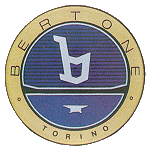 Giovanni Bertone was born in 1884, the sixth of seven sons. At a relatively early age he left the family farm to learn to be a
cartwright in his local village. After perfecting his trade there he moved to Turin where, after a couple of years doing odd
jobs, he found employment at Diatto making bodies for trams.
Giovanni Bertone was born in 1884, the sixth of seven sons. At a relatively early age he left the family farm to learn to be a
cartwright in his local village. After perfecting his trade there he moved to Turin where, after a couple of years doing odd
jobs, he found employment at Diatto making bodies for trams.
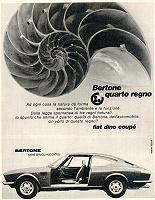 at other ways of finding work. One with which Bertone became heavily involved was the construction of hardtops for the mainly
open cars of the day, a construction which replaced the factory fitted hood on cars such as the Lambda, Itala 61 and Fiat 509
to name but a few. Car bodies were also produced in increasing numbers for the manufacturers themselves including Fiat, Itala,
Diatto, SPA and Lancia, the latter also using Bertone for commercial vehicle bodies. 1933 saw Giovanni’s son Nuccio (officially
christened Giuseppe) formally enter the firm, although he had grown up in the business and had probably spent more time
learning from his father than in school. A year later the company moved premesis to a much larger and better equipped site in Via Peschiera.
at other ways of finding work. One with which Bertone became heavily involved was the construction of hardtops for the mainly
open cars of the day, a construction which replaced the factory fitted hood on cars such as the Lambda, Itala 61 and Fiat 509
to name but a few. Car bodies were also produced in increasing numbers for the manufacturers themselves including Fiat, Itala,
Diatto, SPA and Lancia, the latter also using Bertone for commercial vehicle bodies. 1933 saw Giovanni’s son Nuccio (officially
christened Giuseppe) formally enter the firm, although he had grown up in the business and had probably spent more time
learning from his father than in school. A year later the company moved premesis to a much larger and better equipped site in Via Peschiera.
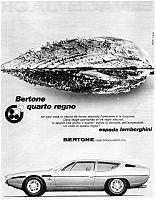 world of motorsport after many years of having dreamt of being a racing driver. He continued racing, with many successes, until
his family finally persuaded him to quit in 1952. For the company, the most significant outcome was the relationship which he
built up with Stanguellini, whose cars he usually raced. This led to the production of the pretty Fiat
1100 based Stanguellini coupe.
world of motorsport after many years of having dreamt of being a racing driver. He continued racing, with many successes, until
his family finally persuaded him to quit in 1952. For the company, the most significant outcome was the relationship which he
built up with Stanguellini, whose cars he usually raced. This led to the production of the pretty Fiat
1100 based Stanguellini coupe.
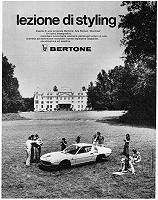 fold, building show cars based on Jaguar and Aston Martin chassis, and early involvement in the design process.
fold, building show cars based on Jaguar and Aston Martin chassis, and early involvement in the design process.
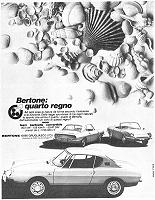 such as Audi, Innocenti, Maserati, Volvo and Citroen. The replacement for the Stratos in rallying, the Fiat Abarth 131 Rally, was also
penned by Bertone whilst in larger volumes for the same manufacturer they designed the Ritmo (or Strada)
and also went on to both design and build the cabriolet version.
such as Audi, Innocenti, Maserati, Volvo and Citroen. The replacement for the Stratos in rallying, the Fiat Abarth 131 Rally, was also
penned by Bertone whilst in larger volumes for the same manufacturer they designed the Ritmo (or Strada)
and also went on to both design and build the cabriolet version.
The official Bertone website.
If you know of any other relevant websites please
send them in.
Bertone comment form
See our picture gallery index for images from museums, motorshows and events.
Use the buttons at the top to navigate further, or
Copyright © 2000 to 2008 CarsfromItaly